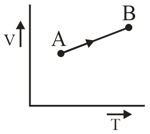Embibe Experts Solutions for Chapter: States of Matter: Gases and Liquids, Exercise 2: Exercise-2
Embibe Experts Chemistry Solutions for Exercise - Embibe Experts Solutions for Chapter: States of Matter: Gases and Liquids, Exercise 2: Exercise-2
Attempt the free practice questions on Chapter 3: States of Matter: Gases and Liquids, Exercise 2: Exercise-2 with hints and solutions to strengthen your understanding. Alpha Question Bank for Engineering: Chemistry solutions are prepared by Experienced Embibe Experts.
Questions from Embibe Experts Solutions for Chapter: States of Matter: Gases and Liquids, Exercise 2: Exercise-2 with Hints & Solutions
Two flasks of equal volume are connected by a narrow tube (of negligible volume) all at and contain mole of at . One of the flasks is then immersed into a bath kept at , while the other remains at . The final pressure in each flask is:
Two flasks of equal volume are connected by a narrow tube (of negligible volume) all at and contain moles of at . One of the flasks is then immersed into a bath kept at , while the other remains at . The number of moles of in flask and flask are:
A spherical balloon of diameter is to be filled with hydrogen at NTP from a cylinder containing the gas at and . If the cylinder can hold litres of water at NTP, calculate the number of balloons that can be filled up.
At two balloons of equal volume and porosity are filled to a pressure of one with and other with of balloon leaks to a pressure of in How long will it take for balloon to reach a pressure of ?
Which of the following is/are correct?

Which of the following statements are correct?
The rate of diffusion of gases and are in the ratio . If the ratio of their masses present in the mixture is . Then,
If gas is allowed to expand at constant temperature then which of the following does not hold true:
